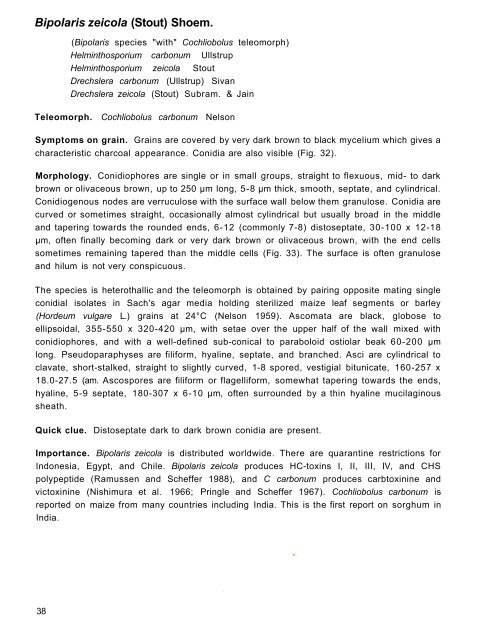A Pictorial Guide for the Identification of Mold ... - OAR@ICRISAT
A Pictorial Guide for the Identification of Mold ... - OAR@ICRISAT
A Pictorial Guide for the Identification of Mold ... - OAR@ICRISAT
You also want an ePaper? Increase the reach of your titles
YUMPU automatically turns print PDFs into web optimized ePapers that Google loves.
Bipolaris zeicola (Stout) Shoem.<br />
(Bipolaris species "with" Cochliobolus teleomorph)<br />
Helminthosporium carbonum Ullstrup<br />
Helminthosporium zeicola Stout<br />
Drechslera carbonum (Ullstrup) Sivan<br />
Drechslera zeicola (Stout) Subram. & Jain<br />
Teleomorph. Cochliobolus carbonum Nelson<br />
Symptoms on grain. Grains are covered by very dark brown to black mycelium which gives a<br />
characteristic charcoal appearance. Conidia are also visible (Fig. 32).<br />
Morphology. Conidiophores are single or in small groups, straight to flexuous, mid- to dark<br />
brown or olivaceous brown, up to 250 μm long, 5-8 μm thick, smooth, septate, and cylindrical.<br />
Conidiogenous nodes are verruculose with <strong>the</strong> surface wall below <strong>the</strong>m granulose. Conidia are<br />
curved or sometimes straight, occasionally almost cylindrical but usually broad in <strong>the</strong> middle<br />
and tapering towards <strong>the</strong> rounded ends, 6-12 (commonly 7-8) distoseptate, 30-100 x 12-18<br />
μm, <strong>of</strong>ten finally becoming dark or very dark brown or olivaceous brown, with <strong>the</strong> end cells<br />
sometimes remaining tapered than <strong>the</strong> middle cells (Fig. 33). The surface is <strong>of</strong>ten granulose<br />
and hilum is not very conspicuous.<br />
The species is heterothallic and <strong>the</strong> teleomorph is obtained by pairing opposite mating single<br />
conidial isolates in Sach's agar media holding sterilized maize leaf segments or barley<br />
(Hordeum vulgare L.) grains at 24°C (Nelson 1959). Ascomata are black, globose to<br />
ellipsoidal, 355-550 x 320-420 μm, with setae over <strong>the</strong> upper half <strong>of</strong> <strong>the</strong> wall mixed with<br />
conidiophores, and with a well-defined sub-conical to paraboloid ostiolar beak 60-200 μm<br />
long. Pseudoparaphyses are fili<strong>for</strong>m, hyaline, septate, and branched. Asci are cylindrical to<br />
clavate, short-stalked, straight to slightly curved, 1-8 spored, vestigial bitunicate, 160-257 x<br />
18.0-27.5 (am. Ascospores are fili<strong>for</strong>m or flagelli<strong>for</strong>m, somewhat tapering towards <strong>the</strong> ends,<br />
hyaline, 5-9 septate, 180-307 x 6-10 μm, <strong>of</strong>ten surrounded by a thin hyaline mucilaginous<br />
sheath.<br />
Quick clue. Distoseptate dark to dark brown conidia are present.<br />
Importance. Bipolaris zeicola is distributed worldwide. There are quarantine restrictions <strong>for</strong><br />
Indonesia, Egypt, and Chile. Bipolaris zeicola produces HC-toxins I, II, III, IV, and CHS<br />
polypeptide (Ramussen and Scheffer 1988), and C carbonum produces carbtoxinine and<br />
victoxinine (Nishimura et al. 1966; Pringle and Scheffer 1967). Cochliobolus carbonum is<br />
reported on maize from many countries including India. This is <strong>the</strong> first report on sorghum in<br />
India.<br />
38<br />
r
















